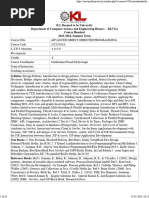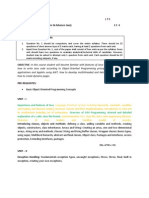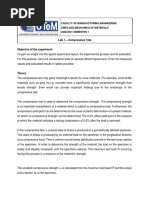0 ratings0% found this document useful (0 votes)
341 viewsAdvance Java & J2EE Syllabus
This document outlines the course objectives, modules, topics, and outcomes for an Advanced Java and J2EE course following the CBCS scheme. The 5 modules cover Enumerations and Annotations, Collections, Networking, JavaBeans, and Java Database Connectivity. Students will learn advanced Java concepts, build client-server applications, develop reusable software components, understand servlet architecture, and access databases using JDBC. The goal is for students to be able to apply these skills to develop modular programs and efficiently manage information.
Uploaded by
Prashanth KumarCopyright
© © All Rights Reserved
Available Formats
Download as PDF, TXT or read online on Scribd
0 ratings0% found this document useful (0 votes)
341 viewsAdvance Java & J2EE Syllabus
This document outlines the course objectives, modules, topics, and outcomes for an Advanced Java and J2EE course following the CBCS scheme. The 5 modules cover Enumerations and Annotations, Collections, Networking, JavaBeans, and Java Database Connectivity. Students will learn advanced Java concepts, build client-server applications, develop reusable software components, understand servlet architecture, and access databases using JDBC. The goal is for students to be able to apply these skills to develop modular programs and efficiently manage information.
Uploaded by
Prashanth KumarCopyright
© © All Rights Reserved
Available Formats
Download as PDF, TXT or read online on Scribd
You are on page 1/ 3
ADVANCED JAVA AND J2EE
[As per Choice Based Credit System (CBCS) scheme]
(Effective from the academic year 2016 -2017)
SEMESTER V
Subject Code 15CS553 IA Marks 20
Number of Lecture Hours/Week 3 Exam Marks 80
Total Number of Lecture Hours 40 Exam Hours 03
CREDITS 03
Course objectives: This course will enable students to
Identify the need for advanced Java concepts like Enumerations and Collections
Demonstrate the use of JavaBeans to develop component-based Java software
Adapt servlets to build server side programs
Make use of JDBC to access database through Java Programs
Construct client-server applications using Java socket API
Module 1 Teaching
Hours
Enumerations, Autoboxing and Annotations(metadata) Enumerations, 8 Hours
Enumeration fundamentals, the values() and valueOf() Methods, java
enumerations are class types, enumerations Inherits Enum, example, type
wrappers, Autoboxing, Autoboxing and Methods, Autoboxing/Unboxing occurs
in Expressions, Autoboxing/Unboxing Boolean and character values ,
Autoboxing/Unboxing helps prevent errors, A word of Warning. Annotations,
Annotation basics, specifying retention policy, Obtaining Annotations at run
time by use of reflection, Annotated element Interface, Using Default values,
Marker Annotations, Single Member annotations, Built-In annotations.`
Textbook 1: Ch 12
Module 2
The collections and Framework Collections Overview, Recent Changes to 8 Hours
Collections, The Collection Interfaces, The Collection Classes, Accessing a
collection Via an Iterator, Storing User Defined Classes in Collections, The
Random Access Interface, Working With Maps, Comparators, The Collection
Algorithms, Why Generic Collections?, The legacy Classes and Interfaces,
Parting Thoughts on Collections.
Textbook 1: Ch 17
Module 3
Networking: Introduction, Networking Basics, Protocols, Internet Address 8 Hours
(IPv4 and IPv6),Ports, Classes and Interfaces in java.net, class InetAddress,
Constructors of class in Serverside Program InetAddress, Methods of classInet
Address, class URL, Constructors of URL class, Methods of URL class, class
URL Connection, TCP/IP Server Socket Programming, Constructors of
classSocket, Methods of class Socket, Class ServerSocket, Constructors of
class ServerSocket, Methods of class ServerSocket, Communication through
Sockets, Client-side Socketp programming, Users/UnreliableDatagramProtocol,
classDatagramPacket, Constructors,Methods of class Datagram Packets,
DatagramSocket Class, Constructors of class DatagramSocket, Methods of
class DatagramSocket, Programs for Sending and Receiving Datagram,
Creating a Datagram Packet for Sending and Receiving ,Writing Code for
Receiving Datagram.
Textbook 2: Ch 12 and 13
Module 4
Java Beans: Introduction to Java Beans, Attributes of Beans, Benefits of Using 8 Hours
Beans, Properties of a Bean, Java Bean API, Interfaces, Classes of java. bean
package(Java SE 8),class Beans, Class Methods, class Property Change Support,
JAR Files, Creating a JAR file, Viewing the contents of a JAR File, Building
Java Beans with NETBEAN IDE, Building a Composite Component Bean,
Changing Properties of Components, Source Code Generated by IDE, Java
Beans Project 1Construct a Bean Containing a Label and a Scrollbar, Java
Beans Project 2 Construct a Bean to Illustrate MouseEvents, Java Beans
Project 3 Construct a Bean to Illustrate Working of RadioButtons, Java Beans
Project 4Construct a Bean Containing ComboBox, Java Beans Project
5,Application Program, Application Project 1,Application Project 2. Java
Servlets: Introduction, HTTP Basics, Life Cycle of a Servlet, Servlet
Architecture, Setting up Web Server for Servlet Deployment, Classes Defined in
Javax.servlet.http Package, Interfaces Defined in javax.servlet.http Package,
Handling HTTP Request and Response, Writing Servlet, Reading Servlet
Parameters, Classes in javax.servlet Package, Session Tracking and Session
Management, Session Tracking Techniques, Http Redirects in Servlets, Securing
Servlets, Application Program.
Textbook 2: Ch 26, 20
Module 5
Java Database Connectivity: Introduction, JDBC Architecture, Two-tier 8 Hours
Architecture for DataAccess, Three-tier Architecture for DataAccess, Installing
MySQL and MySQL Connector/J,SQL Statements, JDBC Environment Setup,
JDBC Connectivity Model and API, Establishing JDBC Database Connections,
Load and Register the JDBC Driver ,Defining the ConnectionURL, ResultSet
Interface, Navigating the ResultSet , ResultSetMetaData interface, Creating JDBC
Application, JDBC Batch Processing, JDBC Transaction Management,
Application Programs.
Textbook 2: Ch 22
Course outcomes: The students should be able to:
Interpret the need for advanced Java concepts like enumerations and collections in
developing modular and efficient programs
Build client-server applications and TCP/IP socket programs
Develop reusable software components using Java Beans
Describe how servlets fit into Java-based web application architecture
Illustrate database access and details for managing information using the JDBC API
Question paper pattern:
The question paper will have TEN questions.
There will be TWO questions from each module.
Each question will have questions covering all the topics under a module.
The students will have to answer FIVE full questions, selecting ONE full question from each
module.
Text Books:
1. Herbert Schildt: Java The Complete Reference, 7th Edition, Tata McGraw Hill, 2007.
2. Uttam K. Roy , Advanced JAVA Programming. Oxford University Press.
Reference Books:
1. Jim Keogh: J2EE - The Complete Reference, Tata McGraw Hill, 2007.
2. Y. Daniel Liang: Introduction to JAVA Programming, 7th Edition, Pearson
Education, 2007.
3. Stephanie Bodoff et al: The J2EE Tutorial, 2nd Edition, Pearson Education,
2004.
You might also like
- Exhaust and Muffler Design of A Formula SAE Car67% (3)Exhaust and Muffler Design of A Formula SAE Car14 pages
- Airlines Reservation System Analysis and Design40% (5)Airlines Reservation System Analysis and Design30 pages
- Cse4019 Advanced-Java-Programming LP 1.0 1 Cse4019No ratings yetCse4019 Advanced-Java-Programming LP 1.0 1 Cse40193 pages
- Autonomous Institution Affiliated To VTU, BelgaumNo ratings yetAutonomous Institution Affiliated To VTU, Belgaum1 page
- TY BCA (Sci) Sem V Syllabus - 06.062018No ratings yetTY BCA (Sci) Sem V Syllabus - 06.06201824 pages
- Object Oriented Programming Through JavaNo ratings yetObject Oriented Programming Through Java130 pages
- Course Description Document Advanced Java CSF206 AY 2022 23No ratings yetCourse Description Document Advanced Java CSF206 AY 2022 238 pages
- APznzaZi12GfrR3DdR8AzjZNfBOYY69eRQ4bs219SxEkpViSfk5qHCe1JsRvBeaKhVusLG1MW Nc2nkrYXDzxHzE-MOp6FQftfFQ9soNj8...EOyh1uQ009 B9Z6QSB8pTachu3weAt WoJFc1FMOlcubDaVR76wbsjL g3VIRaSL6dPgeKFxKxgtHjETs5R45EQrpm2vdkmDK9jQGxGPESHCajQAafVuFLxk0=100% (1)APznzaZi12GfrR3DdR8AzjZNfBOYY69eRQ4bs219SxEkpViSfk5qHCe1JsRvBeaKhVusLG1MW Nc2nkrYXDzxHzE-MOp6FQftfFQ9soNj8...EOyh1uQ009 B9Z6QSB8pTachu3weAt WoJFc1FMOlcubDaVR76wbsjL g3VIRaSL6dPgeKFxKxgtHjETs5R45EQrpm2vdkmDK9jQGxGPESHCajQAafVuFLxk0=2 pages
- Java-J2Ee: Object-Oriented Programming (OOPS) ConceptsNo ratings yetJava-J2Ee: Object-Oriented Programming (OOPS) Concepts12 pages
- Syllabus of B.Tech (CSE) 2nd Year - With CO and PO MappingNo ratings yetSyllabus of B.Tech (CSE) 2nd Year - With CO and PO Mapping27 pages
- B. C. A. (Semester V) 501: Java ProgrammingNo ratings yetB. C. A. (Semester V) 501: Java Programming68 pages
- Object Oriented Programming Through JavaNo ratings yetObject Oriented Programming Through Java130 pages
- EContent 7 2023 10 25 14 03 57 01CE0308ADVANCEJAVATECHNOLOGYpdf 2023 07 11 12 14 10No ratings yetEContent 7 2023 10 25 14 03 57 01CE0308ADVANCEJAVATECHNOLOGYpdf 2023 07 11 12 14 104 pages
- Course-Outline of Java Programming CS 403No ratings yetCourse-Outline of Java Programming CS 4039 pages
- The Three OOP Principles: String Handling 1. Learning String OperationsNo ratings yetThe Three OOP Principles: String Handling 1. Learning String Operations2 pages
- Java/J2EE Design Patterns Interview Questions You'll Most Likely Be Asked: Second EditionFrom EverandJava/J2EE Design Patterns Interview Questions You'll Most Likely Be Asked: Second EditionNo ratings yet
- Coduri de Defect: Combustibil (EKPS (Fuel Pump Control) - Diagnose)No ratings yetCoduri de Defect: Combustibil (EKPS (Fuel Pump Control) - Diagnose)4 pages
- Ear Lobe Patterns Comparison Among Males and Females of Madhya PradeshNo ratings yetEar Lobe Patterns Comparison Among Males and Females of Madhya Pradesh6 pages
- Inventory Control Using ABC and Min-Max Analysis oNo ratings yetInventory Control Using ABC and Min-Max Analysis o11 pages
- Invertis University, Bareilly: First Shift - Block 3 Second Shift - Block 1 & 2 Odd Semester Examination 2018-19No ratings yetInvertis University, Bareilly: First Shift - Block 3 Second Shift - Block 1 & 2 Odd Semester Examination 2018-1914 pages

























































































